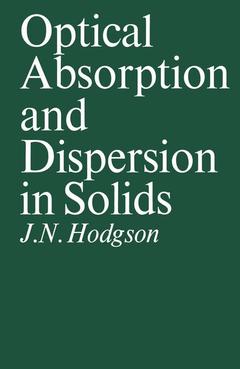Optical Absorption and Dispersion in Solids, 1970
Langue : Anglais
Auteur : Hodgson John Noel.

The electromagnetic theory of Maxwell and the electron theory of Lorentz and Drude stimulated a great deal of experimental work on the optical properties of solids in the late nineteenth and early twentieth centuries. The time was not then ripe, however, for general progress in this field. The experimental techniques were not available to produce suitable specimens for optical measurements with well defined structure and purity. On the theoretical side, the classical electron theory provided only a very incomplete account of the interaction of light waves with matter. The centre of interest in optical research moved to atomic and molecular spectroscopy where quantitative results were easier to obtain. The quantum theory, starting with Bohr's theory of 1913, provided a highly successful basis for the interpretation of the optical spectra of atoms and molecules. The present-day theory of the optical properties of solids is based on the quantum theory of electrons in solids, developed from the early researches of Sommerfeld and Bloch, and the theory of lattice vibrations originating in the research by Born. The formal con nection between optical absorption and electron wave functions in solids has been well known since the 1930s but it is only recently that electron energy band calculations have achieved sufficient accuracy to make profitable a comparison of experimental and theoretical results. Without some guidance from a theoretical band structure calculation, it would be difficult to make any progress with the in terpretation of an optical absorption spectrum.
1. Macroscopic Theory.- 1.1 Electromagnetic field in a solid.- 1.2 Dielectric constant and optical conductivity.- 1.3 Crystal symmetry.- 1.4 Propagation of waves.- 1.5 Kramers-Krönig relations.- 1.6 The sum rule.- 1.7 Dispersion theory of classical oscillators.- 2. Crystal Lattice Absorption.- 2.1 Vibrational modes of a crystal lattice.- 2.2 Photon-phonon interaction.- 2.3 Microscopic theory of infra-red dispersion.- 2.4 Two-phonon absorption.- 3. Interband Transitions.- 3.1 Electron energy bands.- 3.2 Direct transitions.- 3.3 Critical points.- 3.4 Absorption band edges.- 3.5 Indirect transitions.- 3.6 Infra-red absorption in superconductors.- 4. Free Carrier Absorption.- 4.1 Classical theory.- 4.2 Intraband transitions.- 4.3 Electron transport.- 4.4 Surface admittance.- 4.5 Infra-red absorption in metals.- 4.6 Free carrier absorption in semiconductors.- 5. Plasma Effects.- 5.1 Free electron model.- 5.2 Volume plasmons.- 5.3 Surface plasmons.- 6. Exciton Effects.- 6.1 Electron-hole interaction.- 6.2 Optical absorption.- 6.3 Inert-atom solids and alkali halides.- 6.4 Semiconductors.- 6.5 Spatial dispersion.- 7. Non-Linear Optics.- 7.1 Classification of non-linear effects.- 7.2 Non-linear susceptibilities.- 7.3 Second harmonic generation.- 7.4 Parametric amplification and oscillation.- 7.5 Third order effects.- References.
Date de parution : 07-2013
Ouvrage de 138 p.
14x21.6 cm
Disponible chez l'éditeur (délai d'approvisionnement : 15 jours).
Prix indicatif 52,74 €
Ajouter au panierMots-clés :
band structure; crystal; dispersion; electron; energy; experiment; interaction; optics; research; semiconductor; time
© 2024 LAVOISIER S.A.S.



